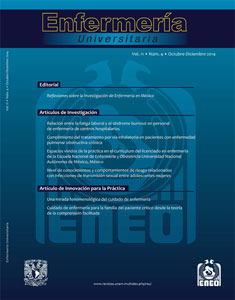Critical patient’s family nursing care from the facilitated sensemaking theory
Main Article Content
Abstract
Introduction: The admission of a loved one into an intensive care ward is a very tense, traumatic, and disagreeable experience for the family, and is associated with a challenge to near death situations, suffering, role rupture and even ignorance. Within this context, nursing interventions, in order that the family may have a better understanding of the situation and what they should do. They should also promote the feelings of tranquility, security, comfort, and favor the adaptation, thus preventing adverse psychological results.
Objective: To design a management proposal which, based on this theory, could allow giving care of quality and excellence to the families of patients in critical status.
Methodology: Analysis and establishment of the facilitated sensemaking theory from the perspective of the Theoretical-Empirical-Conceptual system, and the logical frame model.
Results: A nursing care plan is presented which, formulated from the facilitated sensemaking theory and the NANDA, NIC, NOC taxonomies, shows issues related to the assessment, results, and interventions in four priority evaluations of the possible more frequent situations which the family must face when a loved one is in a critical health status.
Conclusion: A standardized care plan based on the facilitated sensemaking theory is a strategy to implement nursing knowledge that: 1) consolidates an integral care model which favors the visibility, continuity, efficiency, and excellence of care; 2) reduces the hostility experience by the patient’s family from the intensive care situation.
Publication Facts
Reviewer profiles N/A
Author statements
- Academic society
- N/A
- Publisher
- Universidad Nacional Autónoma de México
Article Details
Dimensions citation
MÉTRICAS
Enfermería Universitaria by Universidad Nacional Autónoma de México it is distributed under the License Creative Commons Attribution - NonCommercial - NoDerivatives 4.0 International
Accepted and published articles become open-access under the terms of the Creative Commons CC BY-NC-ND 4.0 license, which authorizes the reproduction and sharing without commercial purposes, provided the corresponding acknowledgments to their authors. Authors are allowed to manage a self-archive copy of the article’s published version so that they can open-access it in their personal or institutional web pages, and/or any other broad-diffusion space.


